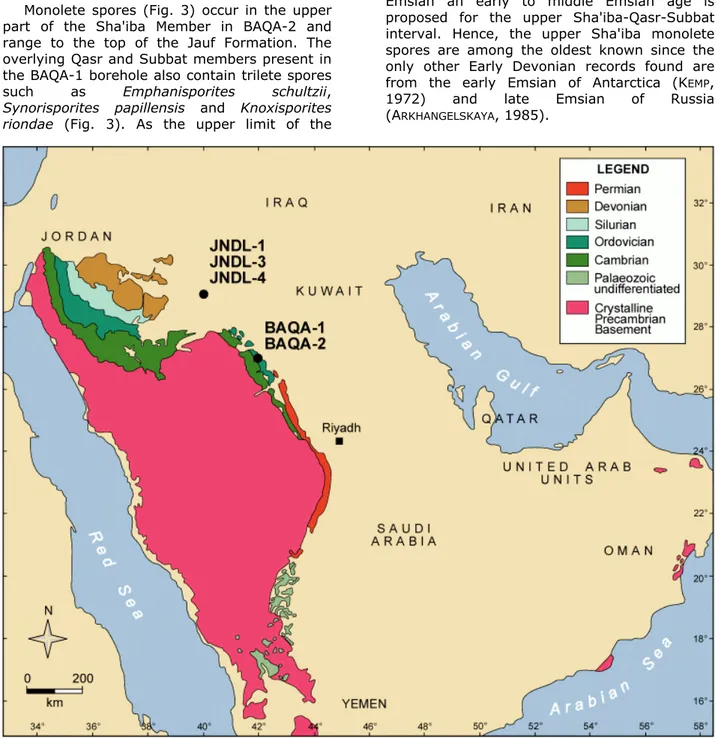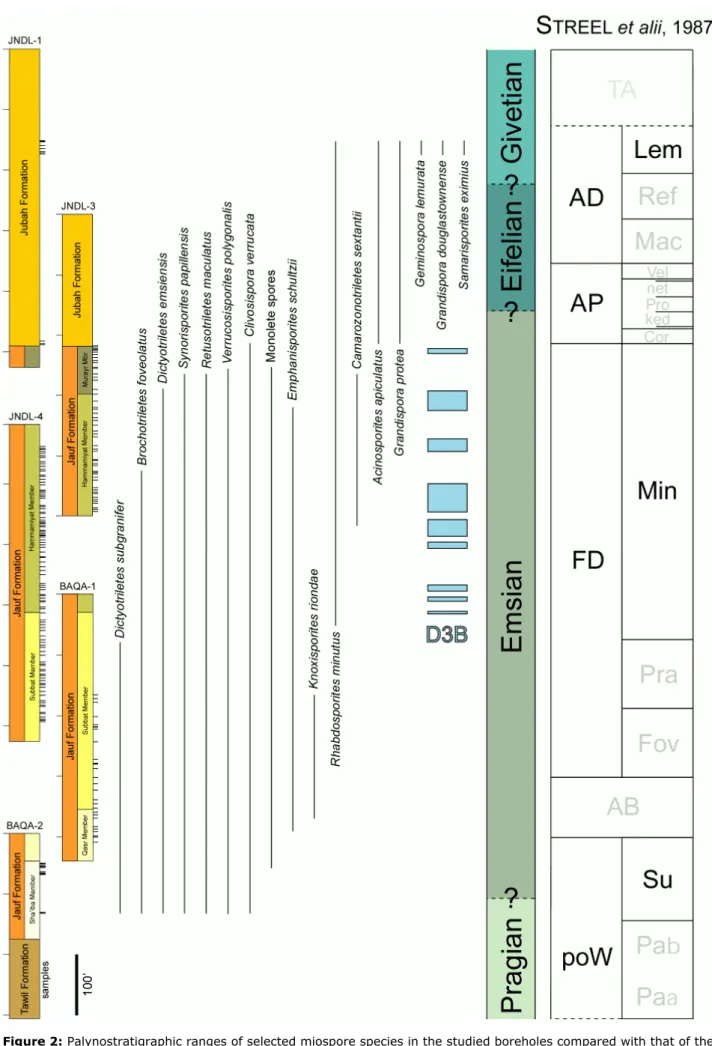Stratigraphic palynology of Devonian boreholes from northern Saudi Arabia
Texte intégral
(2) Carnets de Géologie / Notebooks on Geology - Memoir 2005/02, Abstract 01 (CG2005_M02/01). basis they are assigned a late Pragian age. Monolete spores (Fig. 3) occur in the upper part of the Sha'iba Member in BAQA-2 and range to the top of the Jauf Formation. The overlying Qasr and Subbat members present in the BAQA-1 borehole also contain trilete spores such as Emphanisporites schultzii, Synorisporites papillensis and Knoxisporites riondae (Fig. 3). As the upper limit of the. ranges of these species is confined to the Emsian an early to middle Emsian age is proposed for the upper Sha'iba-Qasr-Subbat interval. Hence, the upper Sha'iba monolete spores are among the oldest known since the only other Early Devonian records found are from the early Emsian of Antarctica (KEMP, 1972) and late Emsian of Russia (ARKHANGELSKAYA, 1985).. Figure 1: Map showing Palaeozoic outcrops in northern parts of the Arabian Peninsula and the location of studied boreholes.. The pseudosaccate miospore Rhabdosporites minutus occurs first in the upper Subbat Member of JNDL-4. Its occurrence marks the base of the Interval Zone Min of Oppel Zone FD (STREEL et alii, 1987). The same levels contain V. polygonalis and Clivosispora verrucata (Fig. 3) species that become extinct before the Emsian/Eifelian boundary. Camarozonotriletes sextantii (Fig. 3) makes its first inception in the overlying Hammamiyat Member of JNDL-4. Miospore abundance and species diversity are low in the Hammamiyat Member of the. JNDL-3 section, so no palynozonal boundaries can be defined. The Murayr Member in JNDL-3 is more productive and seems to be of late Emsian age, based on the extinction of C. sextantii, V. polygonalis and Retusotriletes maculatus (Fig. 3) in the upper part of this unit. The miospore assemblages show a marked increase in diversity, as well as a change in composition, in the lower part of the Jubah Formation as found in the JNDL-1 borehole. This characteristic allowed early workers (HEMER. 4.
(3) Carnets de Géologie / Notebooks on Geology - Memoir 2005/02, Abstract 01 (CG2005_M02/01). Figure 2: Palynostratigraphic ranges of selected miospore species in the studied boreholes compared with that of the west European zonation of STREEL et alii (1987). Stratigraphic distribution of marine pulses containing D3B assemblages also shown. 5.
(4) Carnets de Géologie / Notebooks on Geology - Memoir 2005/02, Abstract 01 (CG2005_M02/01). 6.
(5) Carnets de Géologie / Notebooks on Geology - Memoir 2005/02, Abstract 01 (CG2005_M02/01). ◄. Figure 3: Photomicrographs of miospores from the studied boreholes. Brochotriletes foveolatus. Borehole BAQA-1, sample & slide 169.1', EFC K39-40. 2. Clivosispora verrucata. Borehole JNDL-4, sample & slide 87.2', EFC F34/1. 3. Camarozonotriletes sextantii. Borehole JNDL-4, sample & slide 75.0', EFC Q-R29. 4. Dictyotriletes emsiensis. Borehole BAQA-2, sample & slide 56.0', EFC X46. 5. Dictyotriletes subgranifer. Borehole BAQA-1, sample & slide 366.9', EFC G28. 6. Knoxisporites riondae. Borehole BAQA-1, sample & slide 285.5', EFC R48/3. 7. Knoxisporites riondae. Borehole BAQA-1, sample & slide 366.9', EFC K27/1. 8. Geminospora lemurata. Borehole JNDL-1, sample 172.7', slide 60845, EFC G31. 9. Samarisporites eximius. Borehole JNDL-1, sample & slide 167.8', EFC O34/2. 10. Monolete spores. Borehole BAQA-2, sample & slide 56.0', EFC S27. 11. Synorisporites papillensis. Borehole BAQA-1, sample & slide 222.5', EFC W51/3. 12. Synorisporites papillensis. Borehole BAQA-2, sample & slide 50.2, EFC R26. 13. Retusotriletes maculatus. Borehole BAQA-1, sample & slide 395.2', EFC W49. 14. Verrucosisporites polygonalis. Borehole JNDL-4, sample & slide 87.2', EFC F38/2.. & NYGREEN, 1967) to recognize a Devonian (Givetian-Frasnian) section (now termed Jubah Formation) younger than the marine, lower Middle and Lower Devonian Jauf Formation known up to that time. Simple trilete spores like Retusotriletes and Apiculiretusispora are much less abundant in the lower part of the Jubah Formation than in the underlying succession, and more complexly structured and ornamented species such as Acinosporites apiculatus and Grandispora protea appear for the first time. They characterize the AP Oppel Zone of STREEL et alii (1987) and in the sequences of western Europe appear just prior to the Emsian/Eifelian boundary. As C. verrucata is still present in the lower part of the Jubah Formation that portion of the formation may be of latest Emsian age. The distinctive camerate spores Geminospora lemurata, Grandispora protea, G. douglastownense and the zonate miospore Samarisporites eximius (Fig. 3) occur in the upper part of JNDL-1. The first occurrence of G. lemurata defines the base of the Lem Interval Zone of STREEL et alii (1987) within their AD Oppel Zone and for this reason the upper part of the JNDL-1 succession is dated Givetian. Similar assemblages have been described from the Jubah Formation in well TRBH-1, approximately 150 km north of the BAQA boreholes (LOBOZIAK & STREEL, 1995), and from borehole S-462 located some 100 km north of the JNDL boreholes (LOBOZIAK, 2000). Palynological events characterized by an. abundance of a monospecific leiosphaerid (Fig. 4.1-3) occur in the Hammamiyat and Murayr members of the Jauf Formation in JNDL-3 and JNDL-4. At some levels, this taxon constitutes almost the whole of the palynological assemblage. These leiosphaerid-rich, lowdiversity assemblages can be related to Palynosubzone D3B defined by AL-HAJRI et alii (1999). Here, this subzone is not as a unique event but is represented by a series of pulses that span some 400 ft of section. In the current study, assemblages of this kind may also include a variety of large aquatic palynomorphs (Fig. 4) that can comprise 10-30% of an assemblage. Most are probably green algae and represent unnamed prasinophyte phycomata (LE HÉRISSÉ, pers. comm.). As recognized here, the D3B episode is restricted to the Min Interval Zone of western Europe and thus is middle to late Emsian in age.. Conclusion This palynological study determines with great precision the age of the Jauf Formation in northern Saudi Arabia (late Pragian to late Emsian). The Pragian/Emsian boundary is very probably in the upper part of the Sha'iba Member while the Emsian/Eifelian boundary could be in the lower part of the Jubah Formation. However, taxa characteristic of the Eifelian are absent probably because of the 300 ft sample gap in the lower Jubah section of JNDL-1. The youngest samples from the Jubah Formation are Givetian in age. The D3B interval in the JNDL boreholes comprises a series of marine pulses throughout the Hammamiyat and Murayr members of the upper Jauf Formation. Palynostratigraphically they equate with the FD Min western European zones of middle Emsian age. The 400 ft stratigraphic span of the D3B episode is much thicker than it is in eastern Saudi Arabia where it is represented normally by but a few tens of feet. Moreover, in the JNDL boreholes the assemblage is accompanied by many other marine palynomorphs that are rarely evident in the east. Monolete spores appear in the upper Sha'iba Member and range to the top of the Jauf Formation. Their appearance in the earliest Emsian as reported here is among the oldest known global occurrences of this tracheophytic morphotype. The stratigraphic palynology presented here is mainly based on species that are common to the established Euramerican zonations. A palynostratigraphic scheme grounded on species endemic to western Gondwana is under development (BREUER et alii, in preparation) and should lead to more refined Early and Middle Devonian correlations in the Arabian Peninsula.. 7.
(6) Carnets de Géologie / Notebooks on Geology - Memoir 2005/02, Abstract 01 (CG2005_M02/01). 8.
(7) Carnets de Géologie / Notebooks on Geology - Memoir 2005/02, Abstract 01 (CG2005_M02/01). ◄. Figure 4: Photomicrographs of palynomorphs from the D3B interval. 1. Leiosphaeridia spp. Borehole JNDL-4, sample & slide 177.7', EFC J37. 2. Leiosphaeridia spp. Borehole JNDL-4, sample & slide 177.7', EFC P37/4. 3. Leiosphaeridia spp. Borehole JNDL-4, sample & slide 177.7', EFC D37/4. 4. Prasinophyceae sp. 1. Borehole JNDL-3, sample & slide 493.2', EFC O31/2. 5. ? Arpylorus sp. Borehole JNDL-4, sample & slide 221.8', EFC V45. 6. Prasinophyceae sp. 2. Borehole JNDL-4, sample & slide 221.8', EFC M33/3. 7. Prasinophyceae sp. 3. Borehole JNDL-4, sample & slide 221.8', EFC Q40. 8. Prasinophyceae sp. 3. Borehole JNDL-4, sample & slide 221.8', EFC K27/1. 9. Prasinophyceae sp. 2. Borehole JNDL-4, sample & slide 221.8', EFC P48/1.. Acknowledgements We wish to express our gratitude to management of Saudi Aramco for permission to publish this study. We thank M. AL-RUWAILI (Saudi Aramco) for sampling the boreholes, and (Liège) for the M. GIRALDO-MEZZATESTA preparation of palynological slides. P. BREUER is supported by a F.R.I.A grant.. Bibliographic references AL-HAJRI S.A., FILATOFF J., WENDER L.E. & NORTON A.K. (1999).- Stratigraphy and operational palynology of the Devonian System in Saudi Arabia.- GeoArabia, Bahrain, vol. 4, n° 1, p. 53-68. ARKHANGELSKAYA A.D. (1985).- Zonal spore assemblages and stratigraphy of the Lower and Middle Devonian in the Russian Plate.. In: MENNER V.V. & BYVSHEVA T.V. (eds.), Atlas of Spores and Pollen from the Phanerozoic Petroleum Formations in the Russian and Turanian Plates.Trudy Vsesoiuznogo Nauchno-Issledovatel'skogo Geologorazvedochnogo Neftianogo Institute (VNIGNI), Moscow, 253, p. 5-21. & NYGREEN P.W. (1967).HEMER D.O. Devonian palynology of Saudi Arabia.Review of Palaeobotany and Palynology, Amsterdam, vol. 5, n° 1-4, p. 51-61. (1972).Lower Devonian KEMP E.M. palynomorphs from the Horlick Formation, Ohio Range, Antarctica.– Palaeontographica, Abteilung B, Stuttgart, vol. 139, p. 105-124. LOBOZIAK S. (2000).- Middle to Late Devonian miospore biostratigraphy of Saudi Arabia. & OWENS B. (eds.), In: AL-HAJRI S.A. Stratigraphic palynology of the Paleozoic of Saudi Arabia.- GeoArabia Special Publication, Gulf PetroLink, Bahrain, 1, p. 134-145. LOBOZIAK S. & STREEL M. (1995).- Late Lower and Middle Devonian miospores from Saudi Arabia.- Review of Palaeobotany and Palynology, Amsterdam, vol. 89, n° 1-2, p. 105-113. RICHARDSON J.B. & MCGREGOR D.C. (1986).Silurian and Devonian spore zones of the Old Red Sandstone Continent and adjacent regions.- Bulletin of Geological Survey of Canada, Ottawa, vol. 364, p. 1-179. STREEL M., HIGGS K., LOBOZIAK S., RIEGEL W. & STEEMANS P. (1987).- Spore stratigraphy and correlation with faunas and floras in the type marine Devonian of the Ardenne-Rhenish regions.- Review of Palaeobotany and Palynology, Amsterdam, vol. 50, n° 3, p. 211-229.. 9.
(8)
Figure


Documents relatifs
On the basis of this factual evidence, the Panel concluded that the United States had established a prima facie case on the part of the United States, shifting the burden to Turkey
The proposed research model consisted of six independent variables: performance expectancy, effort expectance, social influence, facilitating conditions, trust of Internet, trust
L’archive ouverte pluridisciplinaire HAL, est destinée au dépôt et à la diffusion de documents scientifiques de niveau recherche, publiés ou non, émanant des
The data manipulation stage of AGNI was performed by the algorithms stored in the statically linked kernel library.. Data manipulation in the new version of AGNI
The eight starters were tested by using the same technology applied on raw camel milk (table 1) and the final product gave different pH values at the end of the processing (Figure
Le graphique ci-dessous représente la répartition des médailles d'or gagnées aux Jeux Paralympiques de 2012, pour ces neuf pays.. Explique chacune de
Again, the modification of the spin magnetic moments and the constant magnetization support the hypothesis that a majority spin electron restored by the oxygen vacancy is cap- tured
Contribution of internal (black), external (light gray) and recycled (hatched) (A,C) nitrogen and (B,D) phosphorus resources used for growth under limited condition, for